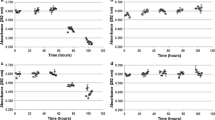Summary
The described high-pressure liquid chromatographic method (reversed phase) permits a differentiating analysis of methyl-hippuric acid isomers and hippuric acid. Diluted urine samples are directly injected. The use of two UV-detectors adjusted to different wavelengths and connected in series allows the fractionated measurement of methylhippuric acid isomers. The analytical reliability criteria of this method are in accordance with the requirements to be met by a laboratory for occupational medicine. The precision within one run is 9%, the accuracy 98–124%. The detection limits of the carbonic acids were found to be in the range of approximately 10μg/ml urine. Examinations of persons exposed to xylene showed a m-/p-isomer ratio of about 3∶1. The excretion rate of the o-isomer is extremely lower.
Zusammenfassung
Mit dem hier beschriebenen hochdruckflüssigkeits-chromatographischen Verfahren ist die differentielle Analyse der Methylhippursäure-Isomeren neben der Hippursäure möglich. Verdünnte Harnproben werden dabei direkt injiziert. Als Trennsystem wird die Reversed-Phase-Chromatographie verwendet. Der Einsatz zweier hintereinander geschalteter UV-Detektoren mit verschieden eingestellten Wellenlängen ermöglicht die fraktionierte Messung der Methylhippursäure-Isomeren. Die analytischen Zuverlässigkeitskriterien der Methode entsprechen den Erfordernissen einer Routinemethode an das arbeitsmedizinisch-toxikologische Laboratorium. Die Präzision in der Serie beträgt 9%, die Richtigkeit 98–124%. Als Nachweisgrenzen für die Carbonsäuren ermittelten wir Konzentrationen von ca. 10 μg/ml Harn. Untersuchungen an beruflich gegenüber Xylolen exponierten Personen haben ergeben, daß ein Verhältnis des m- zum p-Isomeren von ca. 3∶1 besteht. Die Ausscheidungsrate des o-Isomeren liegt wesentlich niedriger.
Similar content being viewed by others
Literatur
Angerer, J.: Int. Arch. Occup. Environ. Health 43, 63–67 (1979)
Buchet, J. P., Lauwerys, R. R.: Brit. J. Industr. Med. 30, 125–128 (1973)
Caperos, J. R., Fernandez, J. G.: Brit. J. Industr. Med. 34, 229–233 (1977)
Engström, K., Husman, K., Rantanen, J.: Int. Arch. Occup. Environ. Health 36, 153–160 (1976)
Gerarde, H. W.: Ind. Hyg. Toxicol., Vol. II, p. 1226–1234. New York: Intersci. 1962
Gossler, K., Schaller, K. H., Zschiesche, W.: Clin. Chim. Acta 78, 91–101 (1977)
Ikeda, M., Ohtsuji, J.: Brit. J. Industr. Med. 26, 244–246 (1969)
Ingersoll, A. W., Babcock, S. H.: Org. Synth. Coll. Vol. II, 328 (1943)
Kira, S.: Brit. J. Industr. Med. 34, 305–309 (1977)
Lauwerys, R.: Scand. J. Work. Environ. Health 1, 139 (1975)
Matsui, H., Kasao, M., Imamura, S.: Brit. J. Industr. Med. 34, 310–313 (1977)
Matsui, H., Kasao, M., Imamura, S.: J. Chromatogr. 145, 231–236 (1978)
Mikulski, P., Wiglusz, R., Bublewska, A., Uselis, J.: Brit. J. Industr. Med. 29, 450 (1972)
Ogata, M., Sugihara, R., Kira, S.: Int. Arch. Occup. Environ. Health 39, 199–206 (1977)
Ogata, M., Takatsuka, Y., Tomokuni, K.: Brit. J. Industr. Med. 28, 382 (1971)
Ogata, M., Tomokuni, K., Takatsuka, Y.: Brit. J. Industr. Med. 27, 43–50 (1970)
Pagnotto, L. D., Liebermann, L. M.: Am. Industr. Hyg. Ass. J. 28, 129–134 (1967)
Roosmalen, P. B. van, Drummond, I.: Brit. J. Industr. Med. 35, 56–60 (1978)
Schaller, K. H., Triebig, G., Valentin, H.: Arbeitsmedizin aktuell. Stuttgart: G. Fischer 1979
Sedivek, V., Flek, J.: Int. Arch. Occup. Environ. Health 37, 205 (1976a)
Sedivek, V., Flek, J.: Int. Arch. Occup. Environ. Health 37, 219 (1976b)
Sedivek, V., Flek, J.: Collect. Czechoslov. Chem. Commun. 35, 3265 (1970)
Sugihara, R., Ogata, M.: Int. Arch. Occup. Environ. Health 41, 281–286 (1978)
Zschiesche, W., Gossler, K., Schaller, K. H., Triebig, G., Weltle, D., Angerer, J.: Berufskrankheiten in der keram. und Glasindustrie. Biochemische Methoden zur Überwachung Styrol-exponierter Personen, Heft 28, S. 25–30. Hrsg.: Berufsgenossenschaft der keramischen und Glas-Industrie, Würzburg 1978/79
Author information
Authors and Affiliations
Rights and permissions
About this article
Cite this article
Goßler, K., Will, W., Schaller, K.H. et al. Direkte, differentielle Bestimmung von Hippursäure und Methyl-Hippursäure-Isomeren im Urin mit der Hochdruckflüssigkeits-Chromatographie. Z. Anal. Chem. 301, 20–24 (1980). https://doi.org/10.1007/BF00481266
Received:
Issue Date:
DOI: https://doi.org/10.1007/BF00481266




